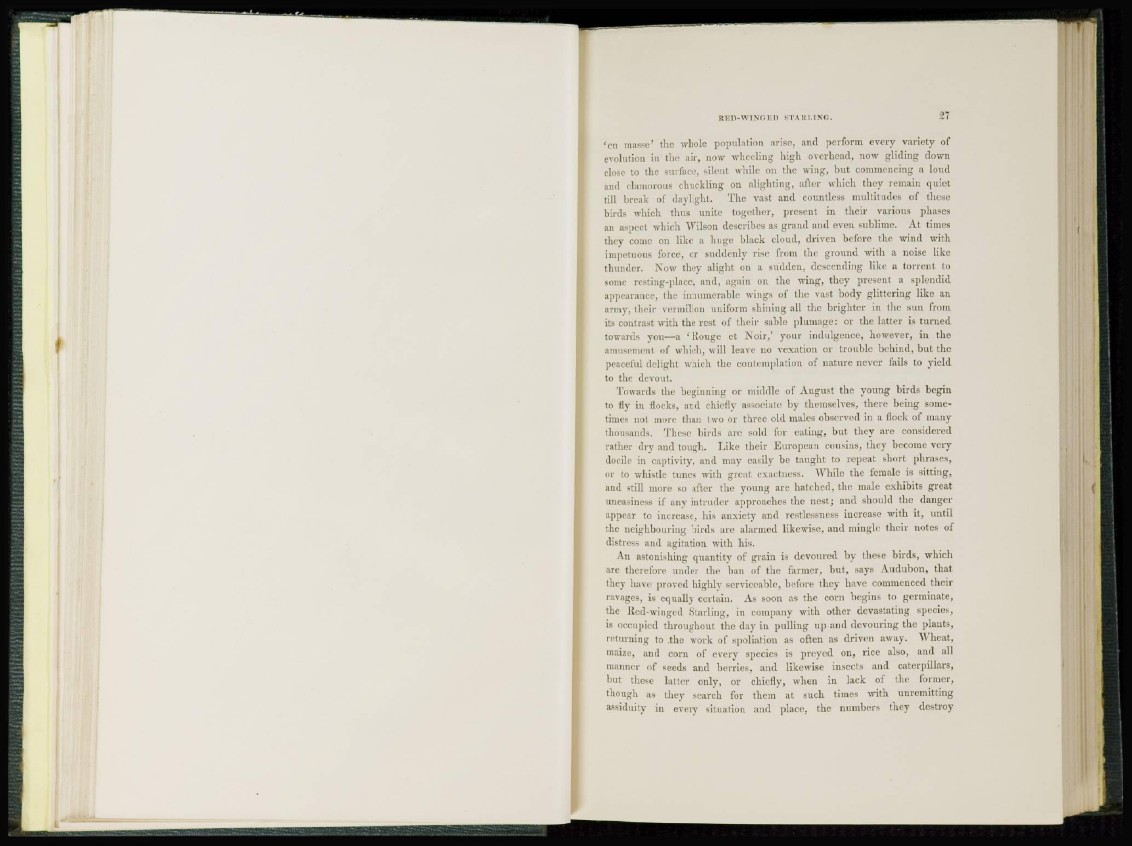
RED-WINGED STARLING.
' e n masse' tlic whole population arise, and perform, every variety of
evolution in the air, now wheeling high overhead, now gliding down
close to the surface, silent while on the wing, but commencing a loud
and clamorous chuckling on alighting, after which they remain quiet
till break of daylight. The vast and countless multitudes of these
birds which thus unite together, present in their various phases
an aspect which Wilson describes as grand and even sublime. At times
they come on like a huge black cloud, driven before the wind with
impetuous force, or suddenly rise from the ground with a noise like
thunder. Now they alight on a sudden, descending like a torrent to
some resting-place, and, again on the wing, they present a splendid
appearance, the innumerable wings of the vast body glittering like an
army, their vermilion uniform shining all the brighter in the sun from
its contrast with the rest of their sable plumage: or the latter is turned
towards you—a 'Rouge ct Xoir,' your indulgence, however, in the
amusement of which, will leave no vexation or trouble behind, but the
peaceful delight which the contemplation of nature never fails to yield
to the devout.
Towards the beginning or middle of August the young birds begin
to fly in flocks, and chiefly associate by themselves, there being sometimes
not more than two or three old males observed in a flock of many
thousands. These birds are sold for eating, but they arc considered
rather dry and tough. Like their European cousins, they become very
docile in captivity, and may easily be taught to repeat short phrases,
or to whistle tunes with great exactness. While the female is sitting,
and still more so after the young arc hatched, the male exhibits great
uneasiness if any intruder approaches the nest; and should the danger
appear to increase, his anxiety and restlessness increase with it, until
the neighbouring birds are alarmed likewise, and mingle their notes of
distress and agitation with his.
An astonishing quantity of grain is devoured by these birds, which
arc therefore under the ban of the farmer, but, says Audubon, that
they have proved highlv serviceable, before they have commenced their
ravages, is equally certain. As soon as the corn begins to germinate,
the Red-winged Starling, in company with other devastating specie-,
is occupied throughout the day in pulling up and devouring the plants,
returning to .the work of spoliation as often as driven away. Wheat,
maize, and corn of every species is proved on, rice also, and all
manner of seeds and berries, and likewise insects and caterpillars,
but these latter only, or chiefly, when in lack of the former,
though as they search for them at such times with unremitting
assiduity in every situation and place, the numbers they destroy